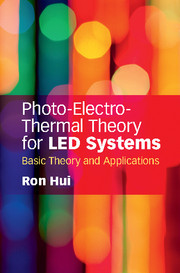Description
Photo-Electro-Thermal Theory for LED Systems
Basic Theory and Applications
Author: Hui Ron
A groundbreaking guide to Light-Emitting Diode (LED) Systems Theory, covering basic concepts, design guidelines, and advanced applications.
Language: English
Subject for Photo-Electro-Thermal Theory for LED Systems:
Publication date: 09-2017
150 p. · 15.7x23.5 cm · Hardback
150 p. · 15.7x23.5 cm · Hardback
Description
/li>Contents
/li>Biography
/li>
Gain a solid understanding of Light-Emitting Diode (LED) Systems Theory with this unique book. Written by a leading expert in LED lighting, it links together the photometric, electrical, thermal and chromatic elements of LED systems into a single, unified framework, and explores their complex interactions with one another. ? Get to grips with chromatic, photometric and thermal modelling of LED systems ? Discover new techniques for precise dimming and colour control ? Learn methods for determining system parameters and internal variables ? Gain insight into advanced applications for LED system design and optimization Providing straightforward and intuitive explanations, this is an ideal guide for professional engineers, graduate students and researchers working on solid-state lighting systems and smart lighting, and those taking advanced courses on LED devices and systems.
1. Basics of light science and device modelling; 2. Steady-state photo-electro-thermal (PET) theory for LED systems; 3. Dynamic PET theory for LED systems; 4. Determination of PET model parameters and internal variables; 5. Unifying PET theory with colorimetry; 6.Chromatic, photometric, and thermal modeling of LED systems; 7. Precise dimming and colour control of LED systems; 8. Applications of PET theory.
Ron Hui is Chair Professor of Electrical Engineering at the University of Hong Kong and Chair Professor of Power Electronics at Imperial College London. He is a recipient of the Institute of Electrical and Electronics Engineers (IEEE) William Newell Power Electronics Award, and a Fellow of the Australian Academy of Technological Sciences and Engineering, the Institution of Engineering and Technology (IET), the Royal Academy of Engineering, and the IEEE.
© 2024 LAVOISIER S.A.S.
These books may interest you

From LED to Solid State LightingPrinciples, Materials, Packaging, Characterization, and Applications 133.68 €

Power Supplies for LED Driving 60.64 €


